|
1. CENTRAL/ WEST AFRICA
Gabon’s decision pending – Producers unable to plan
The government of Gabon has yet to release details of its long term policy on log exports. The shipment of logs harvested before January, when the government decided to ban log exports, should be completed by the end of May, say analysts. But up to now, there is no indication on whether the proposal on quotas and harvest volumes discussed at recent meetings between the government and the timber trade will be adopted.
Concession holders and mill owners are unable to plan ahead for the coming years until government clarifies the situation. In the meantime, buyers are concentrating on export logs available from Cameroon. Prices are rising due to the very strong competition for the volumes available. Demand pressure is also been felt in Congo and in both countries log availability is unlikely to be sufficient to satisfy the demand from China and India. The trend of rising prices is expected to continue through the current quarter.
Alternative species in demand
Some of the lesser traded log species are also in demand as alternatives to the premier timbers which are in short supply. There has been active buying of these alternative species from Cameroon. The premium species are not included (as yet) in the list of timbers that can be exported in log form from Cameroon but there are rumours in the trade that this may change as Cameroon moves to increase tax revenues.
EU log buyers showing more interest
Although European demand for W. African hardwoods is still very weak, there has been some recent interest from buyers in France. Importers in Italy have continued to buy the prime log species on a regular basis, throughout the worst period of the economic recession.
UK trade waits for direction
The UK market is quiet and many in the trade will be waiting for the results of the general election due on May 6th before deciding on their trade prospect for the next few years.
UK housing starts remain low and none of the major political parties have made mention of the need for more home construction or on the need for stimulating activity in the building and construction sector.
Sawnwood markets dull
European (and N. American) tropical sawnwood markets are reported as quiet, with generally low demand. Some traders report a sprinkling of price increases for the premier timbers over the past couple of months but the current mood in the trade is not optimistic and sawnwood prices did not change during April.
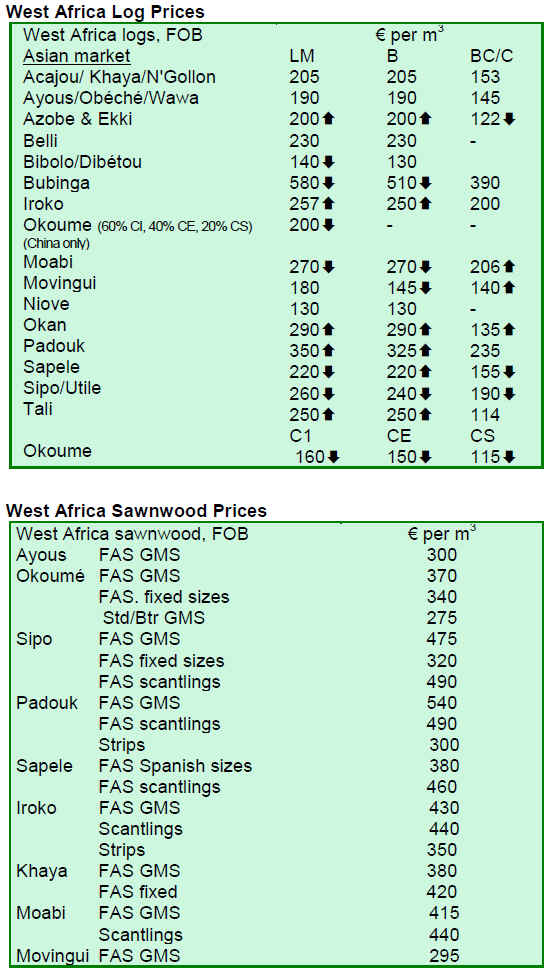
2. GHANA
Stakeholders discovering Sustainable Forest Management
The 3rd Regional Forest Forum aimed at encouraging community partnerships in forestry took place in Takoradi. The deputy Western Regional Minister, Ms. Betty Bosumtwi-Sam disclosed that she was happy there had been a growing and increasing shift from the notion that forest management was the sole preserve of the Forestry Commission to the understanding that all stakeholders needed to be actively involved in decision making regarding sustainable forest management.
The Minister noted that an inter-agency sub-committee set up by the Ministries of Lands and Natural Resource and National Security, introduced joint military and police patrols to deal with illegal logging.
The forum bearing the theme “Strengthening Partnership for Equitable and Sustainable Forest Management” was organized by the Forestry Commission in collaboration with CARE International (NGO) and USAID.
Tracing technology for timber trade
Ghana is to benefit from software that will help address illegal logging. The Carbon Trust Investments in partnership with Oxford Capital Partners, Albion Ventures and Success Europe, has reportedly invested in the UK-based timber tracing technology company, Helveta, for the development of technology to aid efforts to tackle illegal logging.
The software apparently uses a combination of satellite technology, radio frequency identification (RFID) tags, barcodes and asset tracking. The software allows real-time tracking of harvested timber as it progresses through different points in the supply chain ensuring that no illegally harvested timber is introduced into the supply chain and timber is not being removed.
Other countries where the software has been utilised include Liberia, South Africa, and Bolivia. Helveta is looking to expand into Central African countries where the EU is a key market.
Government asked to review its trade policy
The Association of Ghana Industries (AGI) is requesting government to review the country's trade policy to facilitate industrial growth and economic development through the furniture industry.
The AGI expressed its concerns regarding the recent consequences of endorsement of the World Trade Organization agreement to the furniture industry. According to the spokesman of AGI, trade liberalization in Ghana has resulted in dumping of inferior goods in the country, reports Ghana Web Business News.
The trade organizations in Ghana have not been able to manage the new international business environment efficiently. The results of AGI survey indicate that 75% of the country's furniture were imported because of subdued domestic timber industry.
The Ghanaian government and the AGI are jointly initiating measures to reduce the costs for furniture businesses in the country to increase their competitiveness and domestic market shares. Currently, the domestic wood processing industry is struggling with the high costs of electricity, spare parts and fuel.
Prime rate drops to 15%
After reviewing the economic situation in the country the Monetary Policy Committee (MPC) decided to reduce its Policy Rate to 15% from the February 2010 figure of 16%.
The Governor of the Bank of Ghana said the MPC wants to see these rate cuts to be passed through to the lending rates to reduce the cost of credit and restore economic growth.
It is hoped that with the new prime interest rate businesses can now borrow at competitive rates to boost economic activities in the country. The inflation in the country has been high but having a downward trend from the beginning of the year. The inflation level in March 2010 was 13%.
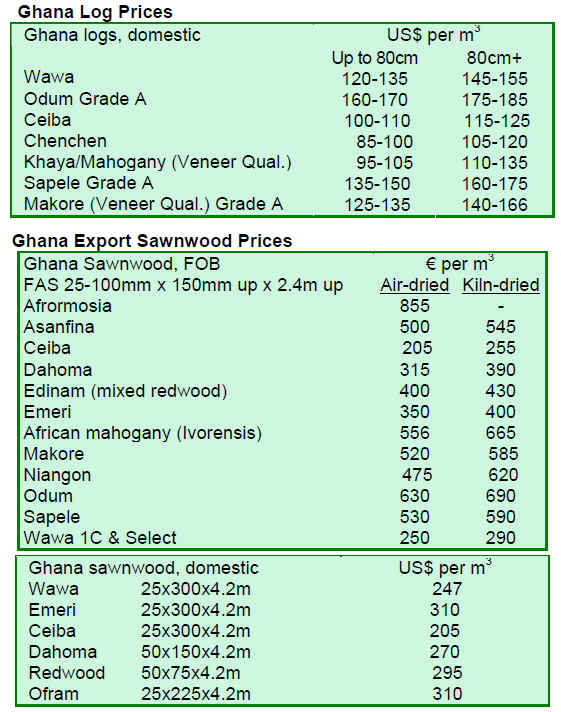
3. MALAYSIA
Dumping suspicions refuted
It is reported that the Sarawak Timber Association (STA) and the Sarawak Timber Industry Development Corporation (STIDC) will jointly prepare a position paper to refute allegations on behalf of some of the alleged plywood exporters from the State of dumping their plywood in South Korea.
STA and the STIDC are working on a joint position paper which will be submitted to the South Korean Trade Commission (KTC).
The South Korean Trade Commission (KTC) had opened an investigation after receiving a petition from the Korean Wood Panel Association claiming that some plywood manufacturers in Malaysia are selling their products below the production cost.
South Korea imported slightly more than 530,000 cubic metres of panel products from Malaysia in 2009. The KTC is expected to follow procedures outlined by the World Trade organization (WTO) in dealing with anti-dumping disputes.
Also in Australia
In related news in December 2009, the Australian Customs and Border Protection Service signalled its initiation to investigate the alleged dumping of plywood exported to Australia from Brazil, Chile, China and Malaysia.
A full description of the goods in question is available in Australian Customs Dumping Notice (ACDN) No.2009/45. This ACDN is available on the internet at www.customs.gov.au
The statement of essential facts (SEF) sets out the facts on Customs and Border Protection activities to base its recommendations to the relevant minister. Due to sampling delays, as well as extensions of time allowed for various interested parties to supply information, the Australian authorities requested an extension of the deadline for the publication of the SEF from initial date of 23 March 2010 to 21 June 2010.
Malaysian International Furniture Fair 2010
The recently concluded Malaysian International Furniture Fair 2010 drew international visitors from 140 countries and regions. Visitors from ASEAN countries made up the largest group at 20%, Europe at 16%, the Middle-East at 13%, the Far-East at 11%. Other Asian countries accounted for 11%,while participation from Africa was11% and the Americas at 8%.
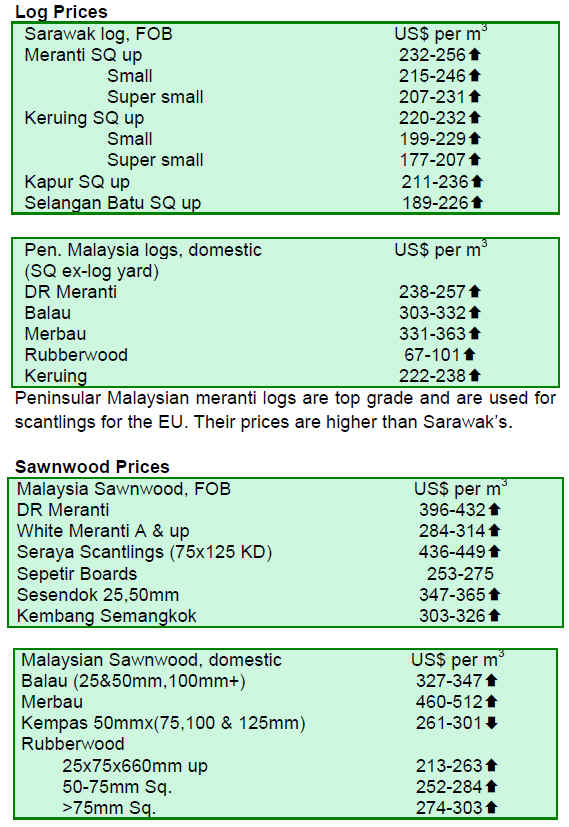
4. INDONESIA
Competitiveness growing
The coming months could bring some relief for the Indonesian timber industry. Rising production costs and demands for higher wages in countries such as Vietnam and China are making Indonesian wood products more price competitive.
Further opportunities for furniture producers, such as Indonesia, are coming from the buoyant real estate market in China. Although the Chinese government is implementing measures to cool the property market so as to avoid an asset bubble, the impact has not yet been felt and investments in property continue.
Upturn in plywood orders from China
Indonesian plywood mills are reporting a upturn in orders and enquiries from China. Some forest plantation companies are also receiving enquiries for Indonesian logs.
Plywood manufacturers commented that, while they had difficulties in filling one container a day about a year ago, the current business climate has improved.
Demand from China has allowed some manufacturers to ship between 3 to 5 containers per day. However, some plywood manufacturers said that the old and redundant equipment in the manufacturing mills is a handicap when it comes to quickly ramping-up production.
US importers active again
Indonesian furniture manufacturers are also reportedly seeing more orders from US buyers especially those in California and Texas. However, US furniture buyers have indicated that prices for Indonesian furniture have moved up recently eroding the price advantage they had over furniture manufacturers in China.
The appreciation of both the Indonesian and Malaysian currencies against the US dollars is making matters worse for the US importers
US buyers expressed concern that furniture price increases may weaken the market which is very price sensitive at present. Nevertheless, buyers indicated that if they could weather the changes in price for the next 3 to 6 months, it would signal that the worst is over for the US furniture market.
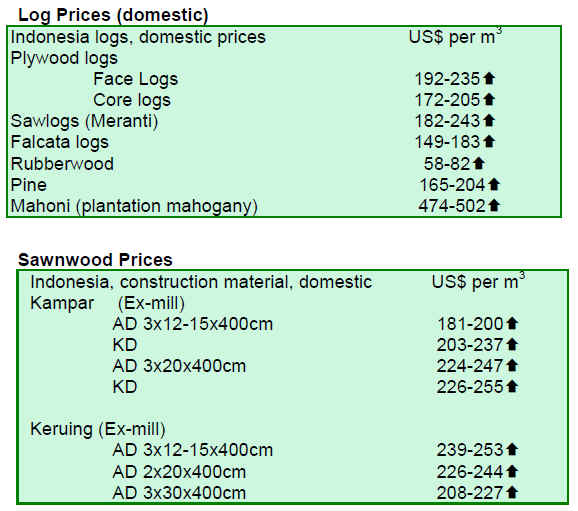
5. MYANMAR
Teak prices slip
The Myanmar Timber Enterprise (MTE) April timber sales of natural forest teak increased slightly in volume from March despite of the long New Year holidays. The recorded Teak log trade volumes in March were 650 tons and in April 681 tons, but the total value conversely declined from EURO 1.153 million to EURO 1.067 million.
The main export countries were Singapore (1 buyer, 211 tons), Hong Kong (1 buyer, 190 tons), India (2 buyers, 111 tons) and Thailand (2 buyers, 72 tons). In the domestic markets there were two buyers and the timber sales totalled the amount of 95 tons.
Promoting non-Teak hardwoods
A Hardwood furniture fair will be held in Yangon from 1st to 3rd May 2010, with a view to promote the use of non-Teak hardwoods in furniture production. Altogether 41 companies will exhibit household, office and school furniture made from Gurjan and other lesser known timbers.
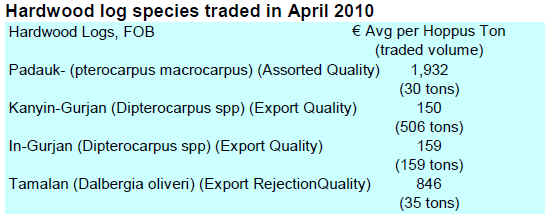
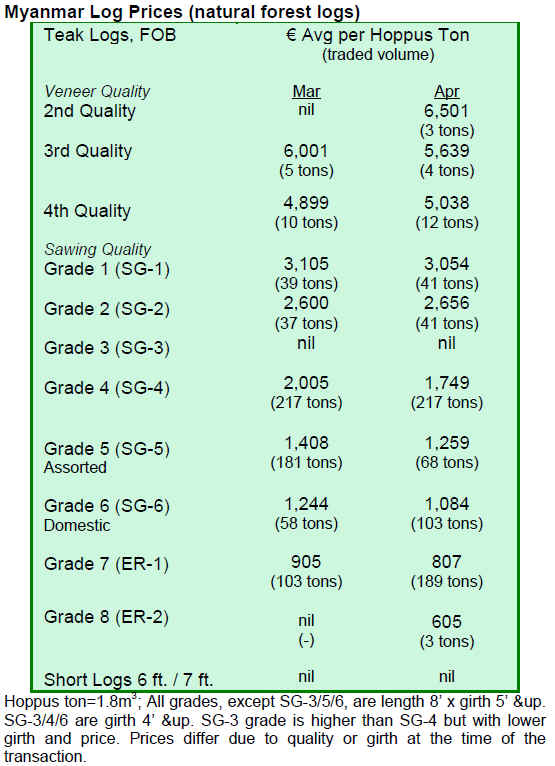
6. INDIA
Weak performance of wood product exports
The North American and European markets are still experiencing the effects of the recession and demand for wood products is weak. Complicating matters is the demand for Lacey Act documentation. Not many Indian exporters are familiar with the Lacey act or its requirements.
The Middle East is slowly stepping out from the construction crisis. The overall shortfall due to these downturns has been about 20% decrease in sector’s exports. The continually strengthening of the Indian Rupee against major currencies has contributed to the fall in exports.
Plywood factories are burdened with dual problem of raw material scarcity and rising costs of logs. Competition amongst the factories in North and South India is a big handicap in rationalising prices.
Revival of housing sector
For the fifth consecutive month the Industrial Production Index surged a hefty 15% during February. The Government’s economic stimulus packages, reduced interest rates and correction in the real estate prices from 10% to 15%, have brought revival in building sector.
Schemes for middle income groups and slums redevelopment programmes are also contributing to active house building keeping wood and wood products industries operation on full capacity.
Interests by industry in utilizing wider range of fast growing tropical plantation species is also a healthy sign. Some of the favoured species are Dalbergia sissoo, Bombax spp., Leucaena leucocephala, Robinia pseudoacacia, Acacia mangium, Azhadirachta indica etc. replacing poplar and eucalyptus.
Targeting self sufficiency in engineered panels
Bajaj Hindustan is the newcomer in engineered panels industry having set up three plants to produce 50,000 cubic metres of particleboard and 160,000 cubic metres of MDF.
The raw material used will be bagasse which they obtain from their sugar mill which processes around 148,000 tonnes of sugarcane per day. The bagasse, which was previous used to fuel the boilers in the sugar mill, will now be used to produce panel products which are in high demand in India.
The company reportedly faced several technical hurdles in the beginning but now the processing of the bagasse is fully understood and the panels have a uniform density and a good surface finish.
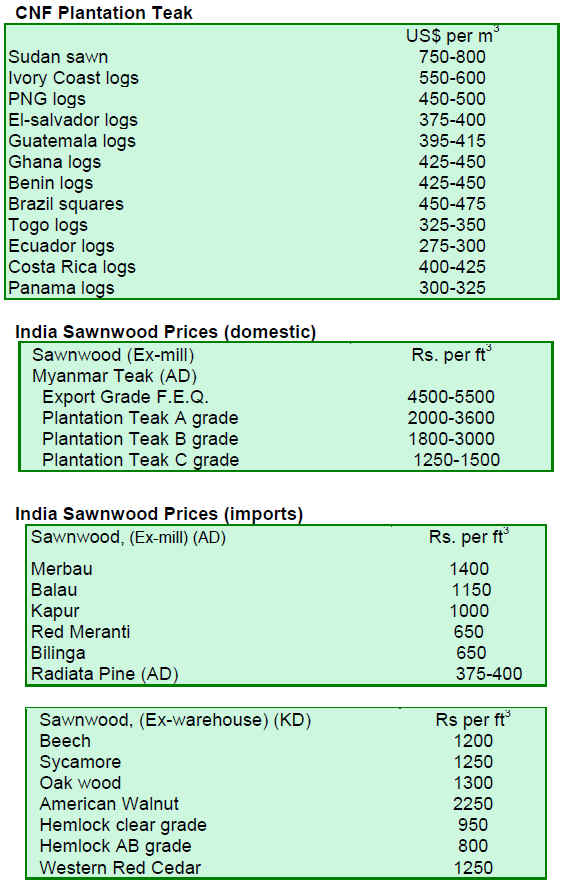
7. BRAZIL
Upswing in exports
In March 2010, exports of timber products (except pulp and paper) showed impressive increase of almost 30% from the US$ 197 million level in March 2009 to US$ 255 mil. The value is also 38% higher than in February 2010.
Pine sawnwood exports increased only slightly (around 1% in value) in March 2010 compared to the same month of 2009 staying around US$ 13 million. However, in terms of volume, exports decreased 7% over the period.
Exports of tropical sawnwood increased in terms of both volume and value, from 43,800 cubic metres in March 2009 to 50,800 cubic metres in March 2010, and from US$ 21.3 million to US$ 25.0 million, respectively over the same period. Such an evolvement corresponds to a 16% increase in volume and 17% in value.
Pine plywood exports gained 32% in value in March 2010 compared to the same period of 2009, from US$ 25 million to US$ 33 million. However, the export volume dropped by 2% during the period, from 100,300 cubic metres to 98,200 cubic metres.
Exports of tropical plywood increased from 8,300 cubic metres in March 2009 to 9,500 cubic metres in March 2010 up 14.5%. In value terms, the rise was 38%.
As for wooden furniture, the export value rose from US$ 45 million in March 2009 to US$ 55 million in March 2010, a 22% increase in exports.
Economic growth stable
In March 2010, the average exchange rate was BRL 1.79 / USD, while it reached BRL 2.32 / USD in the same month of 2009. The appreciation of the Brazilian currency against the US dollar is hitting exporters who already face weak demand in N. American markets.
According to the Brazilian Institute of Geography and Statistics (IBGE), the Consumer Price Index (IPCA) of March 2010 increased 0.52%, remaining behind the rate of 0.78% in February. The accumulated inflation in the first quarter of 2010 ended at 2.06%, gaining from 1.23% observed in the same period of 2009.
In its late March, the Monetary Policy Committee (Copom) of the Central Bank maintained the prime interest rate (Selic) at 8.75% per year, unchanged from July 2009. The annual Selic touched 12.75% in early 2009.
Delta Operation successes
The ‘Delta Operation’ is a joint effort by the Brazilian Institute of the Environment and Natural Renewable Resources (IBAMA), the Federal Police, the Chico Mendes Institute for Biodiversity Conservation (ICMBio), the Amazon Protection System (Sipam) and the National Force to combat deforestation and illegal timber trade in the Brazilian Amazon.
Since the beginning of Delta Operation, Federal agents have inspected 23 containers in Belem port and have seized 16 for violating Forest Control Document (FG), a document used for all forest product transportation in Brazil.
To-date, the Delta Operation has imposed fines totaling around BRL 12 million and has seized about 2,500 cubic metres of illegal logs and sawnwood destined for export.
Forest concession bidding in Pará
The federal government will open a bidding process for forest concessions in a large area of the Amazon along Highway BR-163, in the state of Pará. The concessions will involve sustainable management within the Amana National Forest. Some 60% (364,000 hectares) of the total area (560,000 hectares) of the National Forest will be brought under concession management for a 40 year-term.
Forest concessions are governed by the Public Forest Management Law, an initiative to combat illegal deforestation and logging in the Brazilian Amazon. The law allows companies or cooperatives to exploit timber resources in sustainable manner in public forests and requires a forest management plan.
According to the Brazilian Forest Service the areas to be auctioned in Pará could yield up to 9 million cubic metres of timber as well as other forest products, such as nuts and oils.
The expectation is to attract reliable companies and cooperatives to carry out sustainable forest management that will heat up the region's economy, create jobs and curb illegal logging.
Furniture sector expands sales to UAE
The United Arab Emirates (UAE) is now being targeted as one of the major markets by Brazilian furniture exporters. The UAE has been identified as a potentially important market for the furniture sector by the Brazilian Furniture Manufacturers Association (ABIMOVEL) and the Brazilian Agency for Export and Investment Promotion (APEX) through their ‘Brazilian Furniture project’.
According to ABIMOVEL, annual exports of Brazilian furniture was around US$ 900 million in 2009, less than 1% of worldwide sales covering about US$ 100 billion.
To increase exports to the Arab country, the project aims at two objectives. The first is to attend the largest annual furniture sector fair (INDEX interior design fair), where the Brazilian forest sector traditionally records high sales and is successful in business transactions.
The second initiative is the participation of Arab importers in business rounds in so-called ‘buyer project’, which brings foreign importers for furniture events in Brazil. Altogether 12 projects of this kind are expected to be conducted throughout the year 2010 in Brazil.
Alternative timber species investigated
Fapeam is reporting research conducted by the National Institute of Amazonian Research (INPA) and several other institutions to develop technology to find alternatives to exploit lesser-known timber species from the Amazon forest. INPA recommends six potentially commercial timber species from the Amazon for utilization.
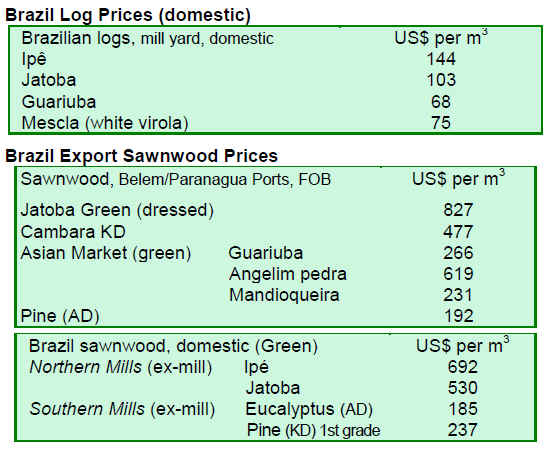
8. PERU
Brisk export trade in February
The Export Association of Peru (ADEX) has reported that February 2010 exports of wood products were US$ 12.7 million up around 30% compared to levels in February 2009. Three main buyers were China, United States and Mexico representing 79% by volume of the total exports.
Exports of parquet to Canada were significant in February. Also, success was recorded with exports of furniture and parts to Italy. Exports of furniture and parts to the United States have not recovered from levels reached during the worst of the financial crisis in 2009.
Exports in categories
The main exported products were semi-manufactured products and sawnwood representing 45% and 33% shares of the total volume.
The accumulated exports from the beginning of the year totalled at US$ 9 million for semi-manufactured products representing a 19% increase over the same period in February 2009.
Sawnwood exports in February were stagnant compared to last year’s level at US$ 7.3 million.
Veneer and plywood are exported mainly to Mexico accounting for over 90% of total exports.
The exports of furniture and its parts were valued at US$ 0.98 million representing a 6.6% decline compared to the same period last year.
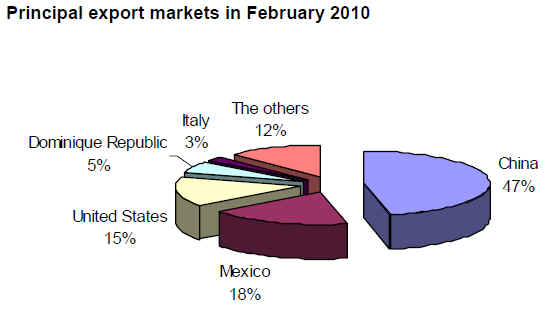

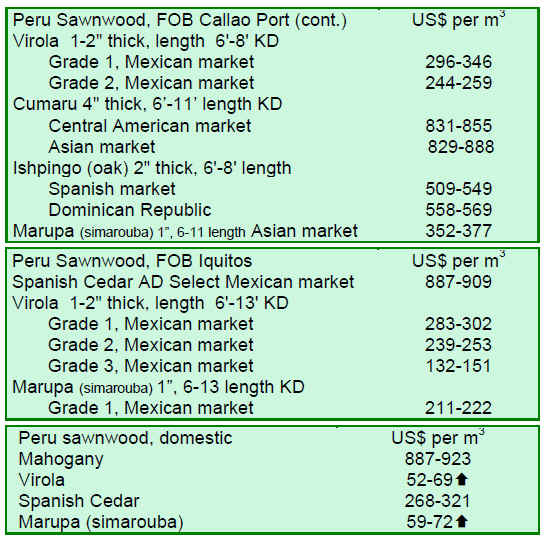
9. Guyana
Good prices reflect strong regional demand
Compared to the previously reported period, export prices for Greenheart logs have remained unchanged. Prices were also fairly stable for all categories of Mora export logs.
However, prices for Purpleheart logs (both standard and fair sawmill quality) have moved up and recently reached a level as high as US$ 290 per cubic metre.
Over the past two weeks several other species were
exported in log form to Asian buyers. The timbers included, Iteballi; Itikiboraballi; Muniridan and Tonka Bea. These species are relatively new to international markets.
During the fortnight under review, sawn wood (dressed and rough sawn) prices have been maintained at the attractive levels seen recently.
Splitwood prices have been buoyant and producers have been encouraged by the average prices which reached as high as US$ 111 per cubic metre recently.
With regard to plywood, Baromalli BB/CC category panels have attracted average prices of US$ 500 per cubic metre, while average prices for Utility category panels reached US$ 460 per cubic metre.
Building capacity to commercialise LUS
Technical officers of the Guyana Forestry Commission and Forest Product Development and Marketing Council have been working along with an expert wood technologist from the United States Forest Service. They are determining local capacity for conducting standard test methods for evaluating properties of Lesser Used Species (LUS) in Guyana.
The objective is to maximize the capacity of existing technology and determine what additional equipment would be required to carry out these standard tests.
The effort is geared toward increasing Guyana’s local database on its over one thousand tropical wood species. It is also to determine and categorize how Guyana’s tropical wood species can be utilized sustainably for commercial use.
Guyana has carried out overseas testing of fifteen LUS and an additional eleven more species are in the pipeline. Promotional activities in relation to the fifteen LUS that feature comparable properties to existing commercial species have already been commenced.
By developing the testing capacity and training for wood properties evaluation means that in the near future Guyana will be independently conducting its own evaluation on wood properties.
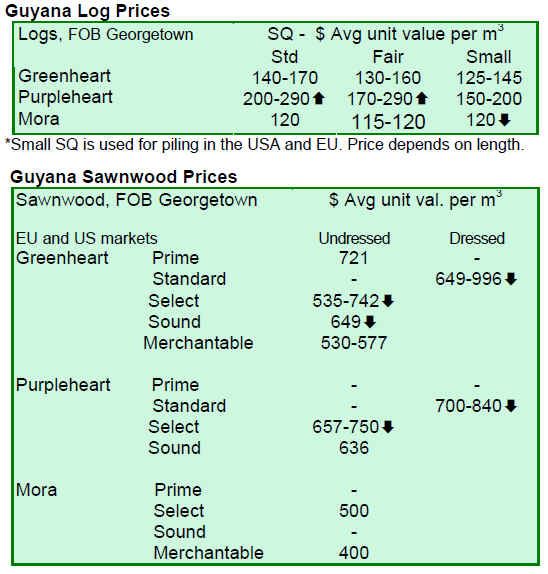
|